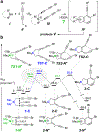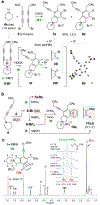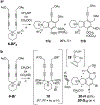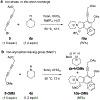Quaternary Ammonium Ion-Tethered (Ambient-Temperature) HDDA Reactions
- PMID: 35442671
- PMCID: PMC9081259
- DOI: 10.1021/jacs.2c00877
Quaternary Ammonium Ion-Tethered (Ambient-Temperature) HDDA Reactions
Abstract
The hexadehydro-Diels-Alder (HDDA) reaction converts a 1,3-diyne bearing a tethered alkyne (the diynophile) into bicyclic benzyne intermediates upon thermal activation. With only a few exceptions, this unimolecular cycloisomerization requires, depending on the nature of the atoms connecting the diyne and diynophile, reaction temperatures of ca. 80-130 °C to achieve a convenient half-life (e.g., 1-10 h) for the reaction. In this report, we divulge a new variant of the HDDA process in which the tether contains a central, quaternized nitrogen atom. This construct significantly lowers the activation barrier for the HDDA cycloisomerization to the benzyne. Moreover, many of the ammonium ion-based, alkyne-containing substrates can be spontaneously assembled, cyclized to benzyne, and trapped in a single-vessel, ambient-temperature operation. DFT calculations provide insights into the origin of the enhanced rate of benzyne formation.
Conflict of interest statement
The authors declare to having no competing interests.
Figures








Similar articles
-
Rapid (≤25 °C) cycloisomerization of anhydride-tethered triynes to benzynes - origin of a remarkable anhydride linker-induced rate enhancement.Chem Sci. 2025 Jan 7;16(6):2898-2906. doi: 10.1039/d4sc07232d. eCollection 2025 Feb 5. Chem Sci. 2025. PMID: 39822903 Free PMC article.
-
Hexadehydro-Diels-Alder Reaction: Benzyne Generation via Cycloisomerization of Tethered Triynes.Chem Rev. 2021 Feb 24;121(4):2413-2444. doi: 10.1021/acs.chemrev.0c00825. Epub 2021 Jan 25. Chem Rev. 2021. PMID: 33492939 Free PMC article. Review.
-
Mechanistic and Kinetic Factors of ortho-Benzyne Formation in Hexadehydro-Diels-Alder (HDDA) Reactions.Chemistry. 2021 May 26;27(30):7978-7991. doi: 10.1002/chem.202100608. Epub 2021 May 2. Chemistry. 2021. PMID: 33783896 Free PMC article. Review.
-
Rates of hexadehydro-Diels-Alder (HDDA) cyclizations: impact of the linker structure.Org Lett. 2014 Sep 5;16(17):4578-81. doi: 10.1021/ol502131r. Epub 2014 Aug 25. Org Lett. 2014. PMID: 25153729 Free PMC article.
-
The Aza-hexadehydro-Diels-Alder Reaction.J Am Chem Soc. 2019 Dec 18;141(50):19575-19580. doi: 10.1021/jacs.9b11243. Epub 2019 Dec 5. J Am Chem Soc. 2019. PMID: 31789026 Free PMC article.
Cited by
-
Acid-catalyzed, Three-component, Spontaneous Cascades of 1,3-Butadiynyl Propargylic Alcohols as a Route to Phthalan Derivatives.ACS Catal. 2025 Jul 18;15(14):12238-12246. doi: 10.1021/acscatal.5c03571. Epub 2025 Jul 6. ACS Catal. 2025. PMID: 40703645
-
Rapid (≤25 °C) cycloisomerization of anhydride-tethered triynes to benzynes - origin of a remarkable anhydride linker-induced rate enhancement.Chem Sci. 2025 Jan 7;16(6):2898-2906. doi: 10.1039/d4sc07232d. eCollection 2025 Feb 5. Chem Sci. 2025. PMID: 39822903 Free PMC article.
-
Aryne-Enabled C-N Arylation of Anilines.Angew Chem Int Ed Engl. 2023 Dec 4;62(49):e202310583. doi: 10.1002/anie.202310583. Epub 2023 Nov 6. Angew Chem Int Ed Engl. 2023. PMID: 37850515 Free PMC article.
References
-
- Menschutkin N Beiträge zur Kenntnis der Affinitätskoeffizienten der Alkylhaloide und der organischen Amine. Z. Physik. Chem 1890, 5, 589–600.
- Menschutkin N Über die Affinitätskoeffizienten der Alkylhaloide und der Amine. Z. Physik. Chem 1890, 6, 41–57.
- Smith MB; March J March’s Advanced Organic Chemistry, 6th edition. Wiley, 2007, pp 555–559. ISBN 13: 978-0-471-72091-7.
-
- Hofmann AW Beiträge zur Kenntnifs der flüchtigen organischen Basen. Justus Liebigs Ann. Chem 1851, 79, 11–39.
-
- Liang Y; Hong X; Yu P; Houk KN Why alkynyl substituents dramatically accelerate hexadehydro-Diels-Alder (HDDA) reactions: Stepwise mechanisms of HDDA cycloadditions. Org. Lett 2014, 16, 5702–5705. - PubMed
- Skraba-Joiner SL; Johnson RP; Agarwal J Dehydropericyclic reactions: Symmetry-controlled routes to strained reactive intermediates. J. Org. Chem 2015, 80, 11779–11787. - PubMed
- Marell DJ; Furan LR; Woods BP; Lei X; Bendelsmith AJ; Cramer CJ; Hoye TR; Kuwata KT Mechanism of the intramolecular hexadehydro-Diels−Alder reaction. J. Org. Chem 2015, 80, 11744–11754. - PMC - PubMed
- Wang T; Niu D; Hoye TR The hexadehydro-Diels–Alder (HDDA) cycloisomerization reaction proceeds by a stepwise mechanism. J. Am. Chem. Soc 2016, 138, 7832–7835. - PMC - PubMed
-
- Miyawaki K; Suzuki R; Kawano T; Ueda I Cycloaromatization of a non-conjugated polyenyne system: Synthesis of 5H-benzo[d]fluoreno[3,2-b]pyrans via diradicals generated from1-[2-{4-(2-alkoxymethylphenyl)butan-1,3-diynyl}]phenylpentan-2,4-diyn-l-ols and trapping evidence for the 1,2-didehydrobenzene diradical. Tetrahedron Lett. 1997, 38, 3943–3946.
- Hoye TR; Baire B; Niu D; Willoughby PH; Woods BP The hexadehydro-Diels–Alder reaction. Nature. 2012, 490, 208–212. - PMC - PubMed
- Karmakar R; Lee D Total synthesis of selaginpulvilin C and D relying on in situ formation of arynes and their hydrogenation. Org. Lett 2016, 18, 6105–6107. - PubMed
- Yoshida S; Shimizu K; Uchida K; Hazama Y; Igawa K; Tomooka K; Hosoya T Construction of condensed polycyclic aromatic frameworks through intramolecular cycloaddition reactions involving arynes bearing an internal alkyne moiety. Chem. Eur. J 2017, 23, 15332–15335. - PubMed
Publication types
MeSH terms
Substances
Grants and funding
LinkOut - more resources
Full Text Sources

